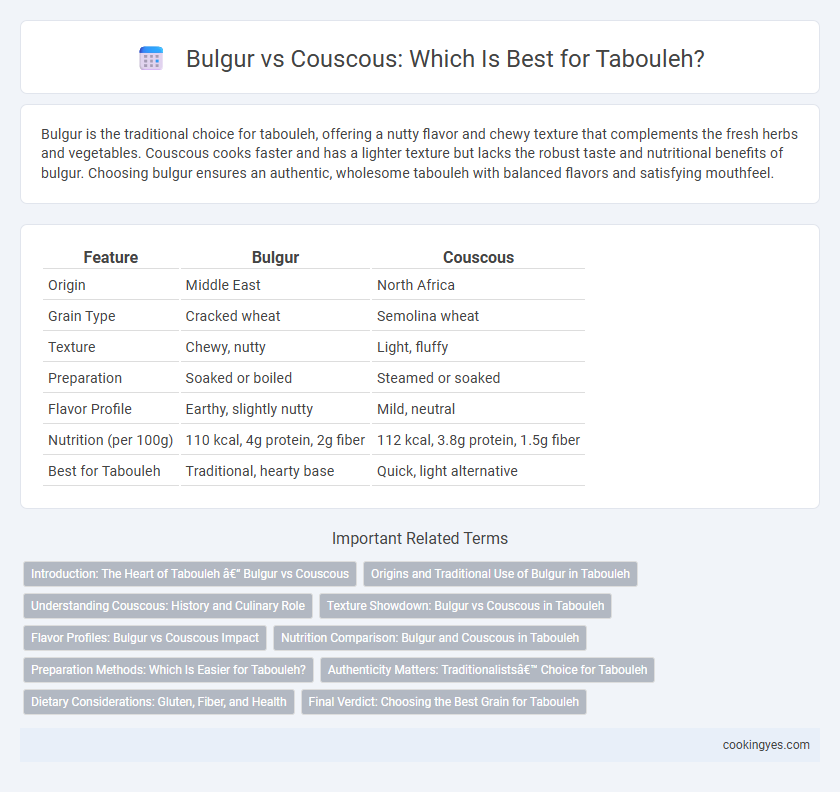Bulgur is the traditional choice for tabouleh, offering a nutty flavor and chewy texture that complements the fresh herbs and vegetables. Couscous cooks faster and has a lighter texture but lacks the robust taste and nutritional benefits of bulgur. Choosing bulgur ensures an authentic, wholesome tabouleh with balanced flavors and satisfying mouthfeel.
Table of Comparison
| Feature | Bulgur | Couscous |
|---|---|---|
| Origin | Middle East | North Africa |
| Grain Type | Cracked wheat | Semolina wheat |
| Texture | Chewy, nutty | Light, fluffy |
| Preparation | Soaked or boiled | Steamed or soaked |
| Flavor Profile | Earthy, slightly nutty | Mild, neutral |
| Nutrition (per 100g) | 110 kcal, 4g protein, 2g fiber | 112 kcal, 3.8g protein, 1.5g fiber |
| Best for Tabouleh | Traditional, hearty base | Quick, light alternative |
Introduction: The Heart of Tabouleh – Bulgur vs Couscous
Bulgur is the traditional heart of authentic tabouleh, prized for its nutty flavor and chewy texture that complement the fresh herbs and lemon dressing. Couscous, while often used as a substitute, lacks the distinctive grain integrity and fiber content that bulgur provides, making it less ideal for maintaining tabouleh's classic consistency. Nutritionally, bulgur offers more protein and dietary fiber, enhancing tabouleh's health benefits beyond couscous's lighter composition.
Origins and Traditional Use of Bulgur in Tabouleh
Bulgur, a cracked wheat product with origins in the ancient Middle East, is traditionally used as the base for authentic tabouleh due to its nutty flavor and chewy texture, which absorb the fresh lemon and herb dressing effectively. Couscous, originating from North Africa, is a finer grain and not historically associated with tabouleh, often resulting in a less textured dish. The distinctive role of bulgur in tabouleh highlights its cultural and culinary significance in Levantine cuisine.
Understanding Couscous: History and Culinary Role
Couscous, originating from North Africa, is a finely granulated semolina wheat product traditionally steamed rather than boiled, contributing a light, fluffy texture ideal for various dishes. Unlike bulgur, which is cracked and parboiled wheat retaining a nutty flavor and chewy texture, couscous offers a neutral base that absorbs herbs and citrus flavors in tabouleh without overpowering them. Its culinary role extends beyond salads, serving as a versatile staple in Moroccan, Algerian, and Tunisian cuisines, making it a culturally rich alternative to bulgur in tabouleh recipes.
Texture Showdown: Bulgur vs Couscous in Tabouleh
Bulgur offers a chewy, nutty texture that enhances the traditional freshness of tabouleh, providing a slightly coarse bite that absorbs the lemon and olive oil dressing well. Couscous delivers a softer, fluffier consistency, making the dish lighter but less texturally complex compared to bulgur. Choosing bulgur preserves the authentic, grainy mouthfeel essential to classic tabouleh, while couscous presents a smooth alternative preferred for quick preparation.
Flavor Profiles: Bulgur vs Couscous Impact
Bulgur offers a nutty, earthy flavor with a chewy texture that enhances the fresh herbs and lemon in tabouleh, providing a hearty and authentic base. Couscous has a milder, slightly sweet taste and fluffier texture, which allows the salad's bright ingredients like parsley and mint to stand out more distinctly. Choosing bulgur intensifies the dish's rustic quality, while couscous creates a lighter, more delicate flavor balance in tabouleh.
Nutrition Comparison: Bulgur and Couscous in Tabouleh
Bulgur, rich in fiber and protein, offers a lower glycemic index compared to couscous, making it a healthier choice for tabouleh. Couscous, primarily made from semolina wheat, contains fewer nutrients and fiber but cooks faster and has a lighter texture. Choosing bulgur enhances the salad's nutritional profile with more vitamins, minerals, and sustained energy release.
Preparation Methods: Which Is Easier for Tabouleh?
Bulgur requires soaking in hot water for about 15-20 minutes to become tender, making it a straightforward and traditional choice for tabouleh preparation. Couscous typically cooks faster by steaming or soaking in boiling water for 5-10 minutes, offering a quicker preparation method. While couscous is easier for rapid tabouleh assembly, bulgur provides the classic texture and flavor essential to authentic tabouleh.
Authenticity Matters: Traditionalists’ Choice for Tabouleh
Bulgur remains the authentic base for traditional Tabouleh, prized for its coarse texture and nutty flavor that perfectly complements the fresh parsley and lemon juice. Couscous, while convenient, lacks the chewy bite and wholesome character inherent to bulgur, making it a less favored choice among purists. Sticking to bulgur ensures a genuine Tabouleh experience that honors its Middle Eastern heritage and original recipe.
Dietary Considerations: Gluten, Fiber, and Health
Bulgur, made from cracked wheat, contains gluten and offers higher fiber content, promoting digestive health and sustained energy release. Couscous, typically made from semolina wheat, also contains gluten but has a finer texture and slightly lower fiber level, making it easier to digest for some individuals. For those with gluten sensitivities or seeking maximum fiber intake, gluten-free grain alternatives like quinoa may be preferable when preparing tabouleh.
Final Verdict: Choosing the Best Grain for Tabouleh
Bulgur is the traditional and preferred grain for tabouleh, offering a nutty flavor and chewy texture that absorbs the fresh herbs and lemon juice perfectly. Couscous, while quicker to prepare, lacks the distinctive texture and taste that bulgur provides, making it a less authentic choice. For the best tabouleh experience, bulgur remains the ideal base grain, delivering classic flavor and texture.
Bulgur vs Couscous for Tabouleh base Infographic

 cookingyes.com
cookingyes.com